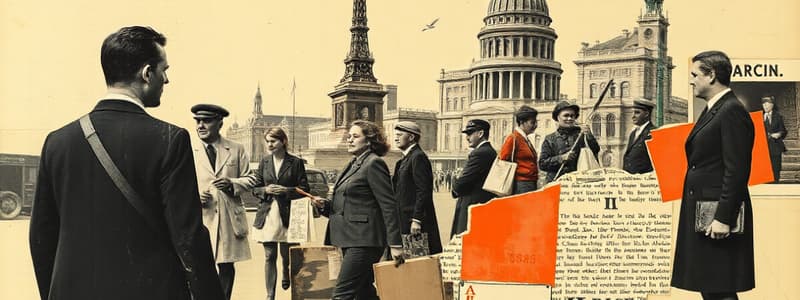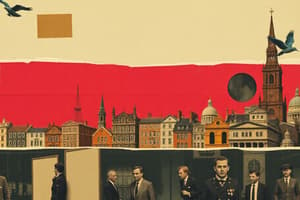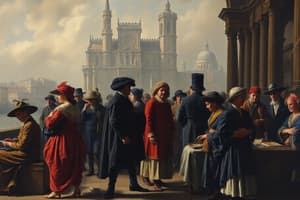Podcast
Questions and Answers
Which of the following scenarios best exemplifies an open system of social stratification?
Which of the following scenarios best exemplifies an open system of social stratification?
- A society where a person's social status is solely determined by their birth.
- A society divided into rigid social classes with no possibility of mobility.
- A society where individuals are assigned occupations based on their family lineage.
- A society where individuals can improve their social standing through education and career advancements. (correct)
In a society with high social inequality, what outcome is most likely?
In a society with high social inequality, what outcome is most likely?
- Equal access to resources and opportunities for all members.
- Redistribution of wealth to ensure everyone has a comfortable standard of living.
- Concentration of wealth and power in the hands of a few. (correct)
- Uniform social status across all segments of the population.
Consider a society where individuals are born into a particular social class and remain in that class throughout their lives with no possibility of changing their social position. Which type of stratification system does this describe?
Consider a society where individuals are born into a particular social class and remain in that class throughout their lives with no possibility of changing their social position. Which type of stratification system does this describe?
- Caste System (correct)
- Meritocracy
- Achieved system
- Open system
How does the concept of 'achieved status' relate to social stratification?
How does the concept of 'achieved status' relate to social stratification?
Which historical example of social stratification relied most heavily on ascribed status?
Which historical example of social stratification relied most heavily on ascribed status?
In what fundamental way does modern slavery differ from some forms of slavery practiced in ancient times?
In what fundamental way does modern slavery differ from some forms of slavery practiced in ancient times?
How does the existence of the 'Untouchables' in the Indian caste system demonstrate social inequality?
How does the existence of the 'Untouchables' in the Indian caste system demonstrate social inequality?
What distinguishes a closed stratification system from an open one?
What distinguishes a closed stratification system from an open one?
Flashcards
Social Stratification
Social Stratification
The structuring of society into ranked layers based on privilege.
Open System
Open System
A system where social status is earned through effort and skill.
Closed System
Closed System
A system where social status is assigned at birth; mobility is limited.
Social Inequality
Social Inequality
Signup and view all the flashcards
Slavery
Slavery
Signup and view all the flashcards
Caste System
Caste System
Signup and view all the flashcards
Aristocrats
Aristocrats
Signup and view all the flashcards
Peasants
Peasants
Signup and view all the flashcards
Study Notes
- Social stratification is how society is structured into ranked layers based on privilege.
- These layers represent different levels of wealth, status, or power.
Types of Stratification Systems:
Open System:
- Status is achieved through effort, skills, and merit.
- Social mobility, moving up or down the social hierarchy, is possible.
- Meritocracy, where people succeed based on ability and hard work, exemplifies this.
Closed System:
-
Status is ascribed, meaning it is given at birth and not chosen.
-
Social mobility is unlikely.
-
The caste system, where individuals are born into a specific group with fixed social status, exemplifies this.
-
Society is shaped like a pyramid, with those at the top holding the most power and privilege.
-
Those at the bottom have fewer resources and opportunities.
-
Social inequality is the uneven distribution of money, power, and opportunities like education and jobs.
Different Types of Stratification:
- Slavery: Individuals are owned and treated as property; during the Transatlantic Slave Trade, enslaved people were permanently taken from Africa and treated with extreme cruelty, fueling racism. Modern slavery exists where vulnerable people are trapped in forced labor.
- Caste System: Found in India, based on Hindu beliefs about reincarnation. People are born into a caste that decides their job and social status, with the lowest caste facing severe discrimination. This is a closed system.
- Estates (Feudal System): Existed in Medieval Europe, society was divided into aristocrats (landowners) at the top and peasants (farmers and workers) at the bottom. Largely ascribed and aristocrats controlled land, and commoners had little freedom.
- Class System: Social mobility is possible. Unlike other systems, it is based on wealth and job status rather than birth; this is an open system, meaning people can move up or down through education, employment, and financial success.
- Overlapping systems meant slavery existed alongside social classes in 19th-century America, and a similar structure was evident in Apartheid South Africa.
Studying That Suits You
Use AI to generate personalized quizzes and flashcards to suit your learning preferences.




